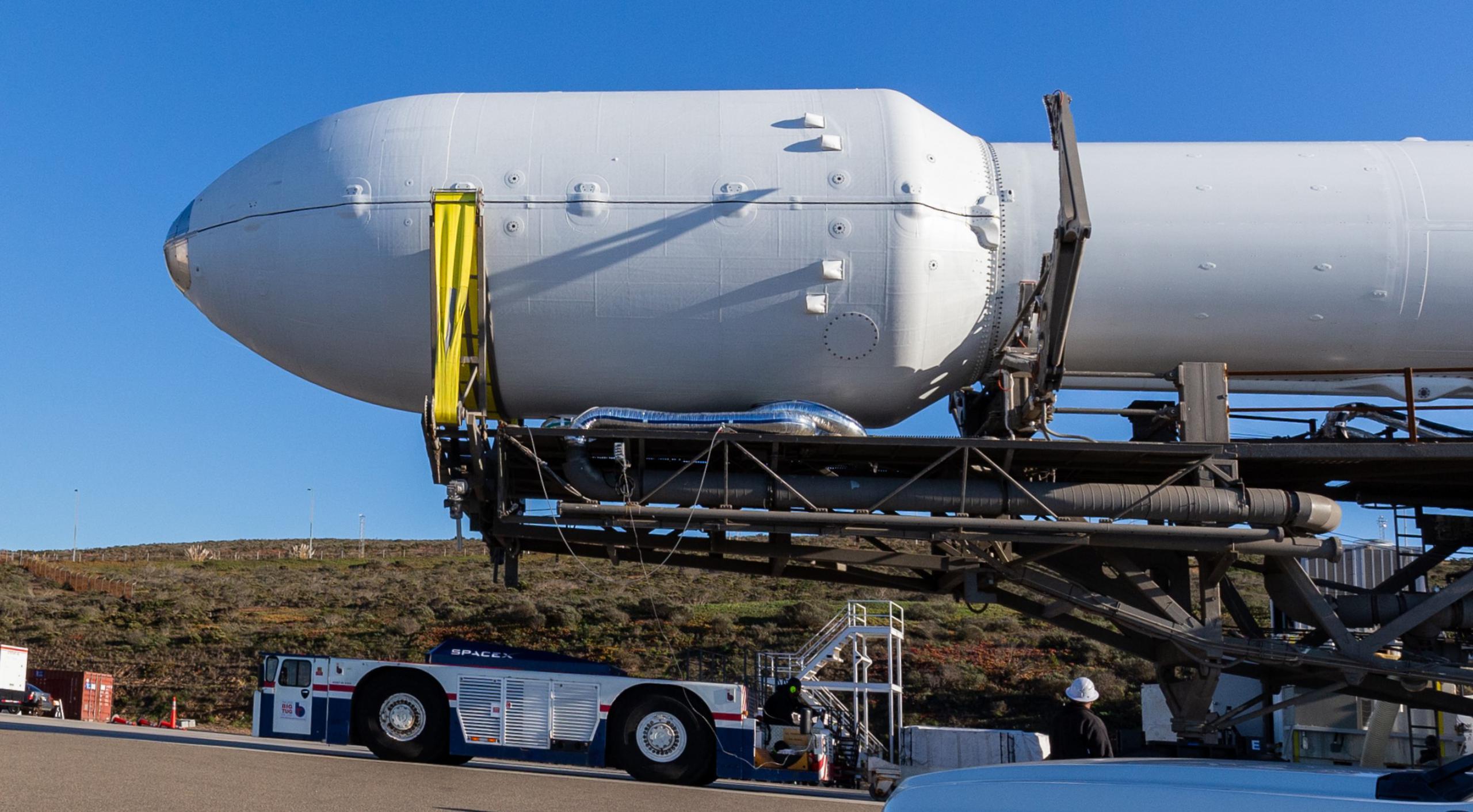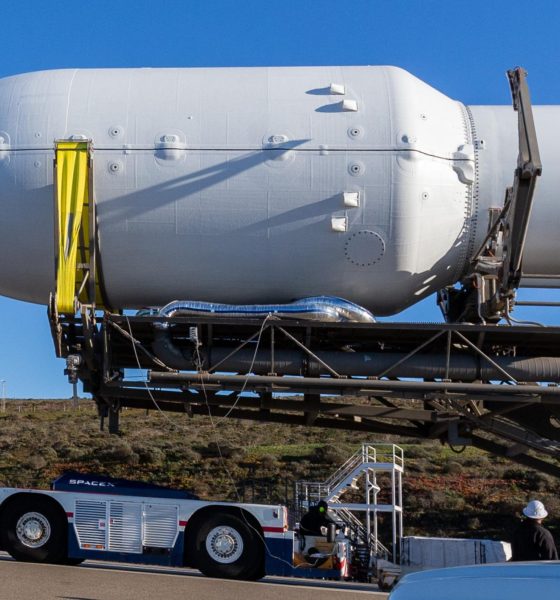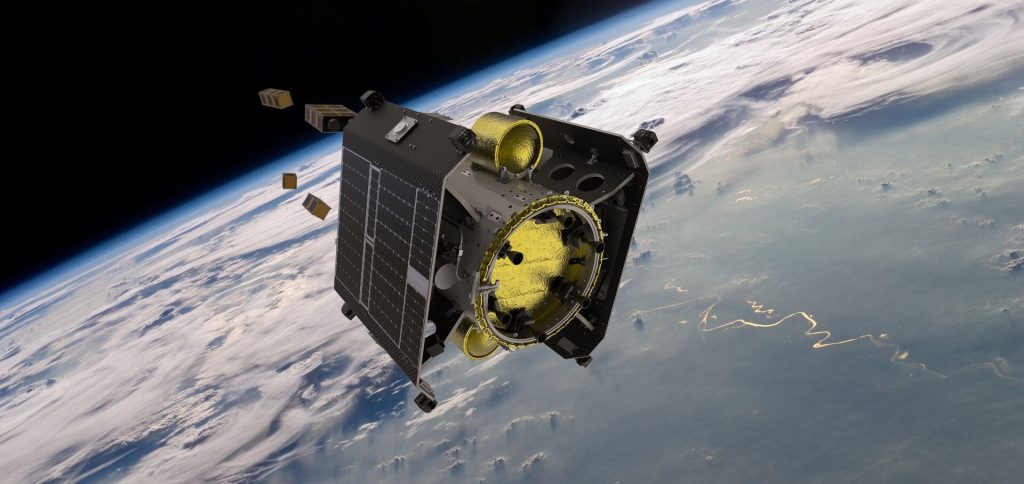

News
SpaceX delays Starlink doubleheader
Update: To “allow additional time for pre-launch checkouts,” SpaceX has delayed Starlink 2-6 from January 30th to 8:15 am PST (16:15 UTC), January 31st and Starlink 5-3 from February 1st to February 2nd.
A pair of SpaceX Falcon 9 rockets are on track to round out the first month of 2023 and kick off the second with a Starlink double-header.
“To complete pre-launch checkouts,” SpaceX delayed its last launch of the month by 24 hours. The first Falcon 9 rocket will launch Starlink 2-6 and a D-Orbit rideshare payload no earlier than 8:29 am PST (16:29 UTC) on Monday, January 30th. The mission will lift off from SpaceX’s Vandenberg Space Force Base (VSFB) SLC-4E pad and head southeast, skirting the California and Mexico coast. In case of bad weather or a minor technical issue, a backup window is available at 12:31 pm PST.
As few as 35.5 or 39.5 hours later, a second Falcon 9 rocket will lift off from SpaceX’s Florida-based NASA Kennedy Space Center LC-39A pad around 3:02 am EST (08:02 UTC) on Tuesday, February 1st.
The update that's rolling out to the fleet makes full use of the front and rear steering travel to minimize turning circle. In this case a reduction of 1.6 feet just over the air— Wes (@wmorrill3) April 16, 2024
Starlink 2-6
Kicking off the pair, Starlink 2-6 will be SpaceX’s ninth Starlink rideshare mission since the company began manifesting third-party payloads on its internet satellite launches in June 2020. Falcon 9 will launch the mission’s main payload – a batch of 49 Starlink V1.5 satellites – to a semi-polar orbit that will see them cross Earth’s equator at an angle of 70 degrees. Ordinarily, the mission would carry 51 Starlinks, but SpaceX has removed a pair of satellites to make room for Italian space logistics company D-Orbit’s ION SCV009 spacecraft.
ION weighs around 160 kilograms (350 lb) on its own and is roughly the size of a large oven. D-Orbit designed the spacecraft to host fixed payloads and deploy rideshare satellites in orbit. It also has a propulsion system that allows it to provide “last-mile delivery services,” offering rideshare customers the ability to tweak the orbit their satellite ends up in. Space tugs like ION aim to give satellite owners some of the benefits of a dedicated rocket launch (custom orbit selection in particular) while retaining most of the cost savings rideshare launches enable.

After reaching orbit, Falcon 9 will deploy ION first, use thrusters to spin itself end over end, and then release all 49 Starlink satellites simultaneously. The spinning stage’s centrifugal force causes the satellite stack to naturally spread out within several hours. The satellites then use reaction wheels to stabilize their orientation, deploy solar panels to begin charging their batteries, and eventually use ion thrusters to climb to operational orbits.
ION SCV009 will attempt to test a new satellite separation system built by EBAD and demonstrate its ability to operate in very low Earth orbit (VLEO). The spacecraft will potentially lower itself to an altitude of 270 kilometers (170 mi).
Starlink 5-3
Starlink 5-3 will carry no rideshare payloads and will likely be nearly identical to Starlink 5-2, which SpaceX successfully launched on January 26th. The latest mission’s stack of 56 Starlink V1.5 satellites weighed 17.4 tons and was the heaviest payload SpaceX has ever launched. Starlink 5-3 is targeting the same orbit and will likely also carry 56 satellites.
Pad 39A last supported SpaceX’s fifth Falcon Heavy launch on January 15th and has been quickly converted back to its single-core Falcon 9 configuration for Starlink 5-3. After the Starlink mission, Pad 39A has at least two Dragon spacecraft launches scheduled before SpaceX will need to convert it back to a triple-booster configuration for Falcon Heavy’s sixth launch.
SpaceX is scheduled to launch Crew Dragon’s Crew-6 astronaut transport mission no earlier than February 26th, and Cargo Dragon’s Spx-27 cargo delivery mission on March 11th. Falcon Heavy is scheduled to launch the giant ViaSat-3 communications satellite no earlier than March 24th.
Tune in below around 8:25 am PST (16:25 UTC) to watch SpaceX Starlink 2-6 launch live.

News
SpaceX shades airline for seeking contract with Amazon’s Starlink rival

SpaceX employees, including its CEO Elon Musk, shaded American Airlines on social media this past weekend due to the company’s reported talks with Amazon’s Starlink rival, Leo.
Starlink has been adopted by several airlines, including United Airlines, Qatar Airways, Hawaiian Airlines, WestJet, Air France, airBaltic, and others. It has gained notoriety as an extremely solid, dependable, and reliable option for airline travel, as traditional options frequently cause users to lose connection to the internet.
Many airlines have made the switch, while others continue to mull the options available to them. American Airlines is one of them.
A report from Bloomberg indicates the airline is thinking of going with a Starlink rival owned by Amazon, called Leo. It was previously referred to as Project Kuiper.
American CEO Robert Isom said (via Bloomberg):
“While there’s Starlink, there are other low-Earth-orbit satellite opportunities that we can look at. We’re making sure that American is going to have what our customers need.”
Isom also said American has been in touch with Amazon about installing Leo on its aircraft, but he would not reveal the status of any discussions with the company.
The report caught the attention of Michael Nicolls, the Vice President of Starlink Engineering at SpaceX, who said:
“Only fly on airlines with good connectivity… and only one source of good connectivity at the moment…”
CEO Elon Musk replied to Nicolls by stating that American Airlines risks losing “a lot of customers if their connectivity solution fails.”
American Airlines will lose a lot of customers if their connectivity solution fails
— Elon Musk (@elonmusk) December 14, 2025
There are over 8,000 Starlink satellites in orbit currently, offering internet coverage in over 150 countries and territories globally. SpaceX expands its array of satellites nearly every week with launches from California and Florida, aiming to offer internet access to everyone across the globe.
Currently, the company is focusing on expanding into new markets, such as Africa and Asia.
News
Tesla Model Y Standard stuns in new range test, besting its Premium siblings
Tesla’s newer vehicles have continued to meet or exceed their EPA estimates. This is a drastic change, as every 2018-2023 model year Tesla that Edmunds assessed did not meet its range estimates.

The Tesla Model Y Standard stunned in a new range test performed by automotive media outlet Edmunds, besting all of its Premium siblings that are more expensive and more luxurious in terms of features.
Testing showed the Model Y Standard exceeded its EPA-estimated range rating of 321 miles, as Edmunds said it is the “longest-range Model Y that we’ve ever put on our loop.” In the past, some vehicles have come up short in comparison with EPA ranges; for example, the Model Y’s previous generation vehicle had an EPA-estimated range of 330 miles, but only drove 310.
Additionally, the Launch Series Model Y, the first configuration to be built in the “Juniper” program, landed perfectly on the EPA’s range estimates at 327 miles.
It was also more efficient than Premium offerings, as it utilized just 22.8 kWh to go 100 miles. The Launch Series used 26.8 kWh to travel the same distance.
It is tested using Edmunds’ traditional EV range testing procedure, which follows a strict route of 60 percent city and 40 percent highway driving. The average speed throughout the trip is 40 MPH, and the car is required to stay within 5 MPH of all posted speed limits.
Each car is also put in its most efficient drive setting, and the climate is kept on auto at 72 degrees.
“All of this most accurately represents the real-world driving that owners do day to day,” the publication says.
With this procedure, testing is as consistent as it can get. Of course, there are other factors, like temperature and traffic density. However, one thing is important to note: Tesla’s newer vehicles have continued to meet or exceed their EPA estimates. This is a drastic change, as every 2018-2023 model year Tesla that Edmunds assessed did not meet its range estimates.
Tesla Model Y Standard vs. Tesla Model Y Premium
Tesla’s two Model Y levels both offer a great option for whichever fits your budget. However, when you sit in both cars, you will notice distinct differences between them.
The Premium definitely has a more luxurious feel, while the Standard is stripped of many of the more premium features, like Vegan Leather Interior, acoustic-lined glass, and a better sound system.
You can read our full review of the Model Y Standard below:
Tesla Model Y Standard Full Review: Is it worth the lower price?
News
Xpeng CEO: Tesla FSD 14.2 has developed “near-Level 4” performance
While acknowledging that imperfections remain, the Xpeng CEO said FSD’s current iteration significantly surpasses last year’s capabilities.

Xpeng CEO He Xiaopeng has offered fresh praise for Tesla’s Full Self-Driving (FSD) system after revisiting Silicon Valley more than a year after his first hands-on experience.
Following extended test drives of Tesla vehicles running the latest FSD software, He stated that the system has made major strides, reinforcing his view that Tesla’s approach to autonomy is indeed the proper path towards autonomy.
Tesla FSD closing in on Level 4 driving
During his visit, He test-drove a Tesla equipped with FSD V14.2. He also rode in a Tesla Robotaxi. Over roughly five hours of driving across Silicon Valley and San Francisco, He said both vehicles delivered consistent and reassuring performance, a notable improvement from his experience a year earlier.
According to He, Tesla’s FSD has evolved from a smooth Level 2 advanced driver assistance system into what he described as a “near-Level 4” experience in terms of capabilities. While acknowledging that imperfections remain, the Xpeng CEO said FSD’s current iteration significantly surpasses last year’s capabilities. He also reiterated his belief that Tesla’s strategy of using the same autonomous software and hardware architecture across private vehicles and robotaxis is the right long-term approach, allowing users to bypass intermediate autonomy stages and move closer to Level 4 functionality.
He previously tested Tesla’s FSD V12.3.6 and Waymo vehicles in California in mid-2024, noting at the time that Waymo performed better in dense urban environments like San Francisco, while Tesla excelled in Silicon Valley and on highways.
Xpeng’s ambitious autonomy roadmap and internal challenge
The Silicon Valley visit also served as a benchmark for Xpeng’s own autonomy ambitions. He stated that Xpeng is looking to improve its VLA autonomous driving system to match the performance of Tesla’s FSD V14.2 within China by August 30, 2026. Xpeng is poised to release its VLA 2.0 smart driving software next quarter, though He cautioned that the initial version will not be able to match FSD V14.2’s capabilities, as noted in a CNEV Post report.
He also added a personal twist to the goal, publicly challenging Xpeng’s autonomous driving team. If the performance target is met by the 2026 deadline, the CEO stated that he will approve the creation of a Chinese-style cafeteria for Xpeng’s Silicon Valley team. If not, Liu Xianming, head of Xpeng’s autonomous driving unit, has pledged to run naked across the Golden Gate Bridge, He noted.








